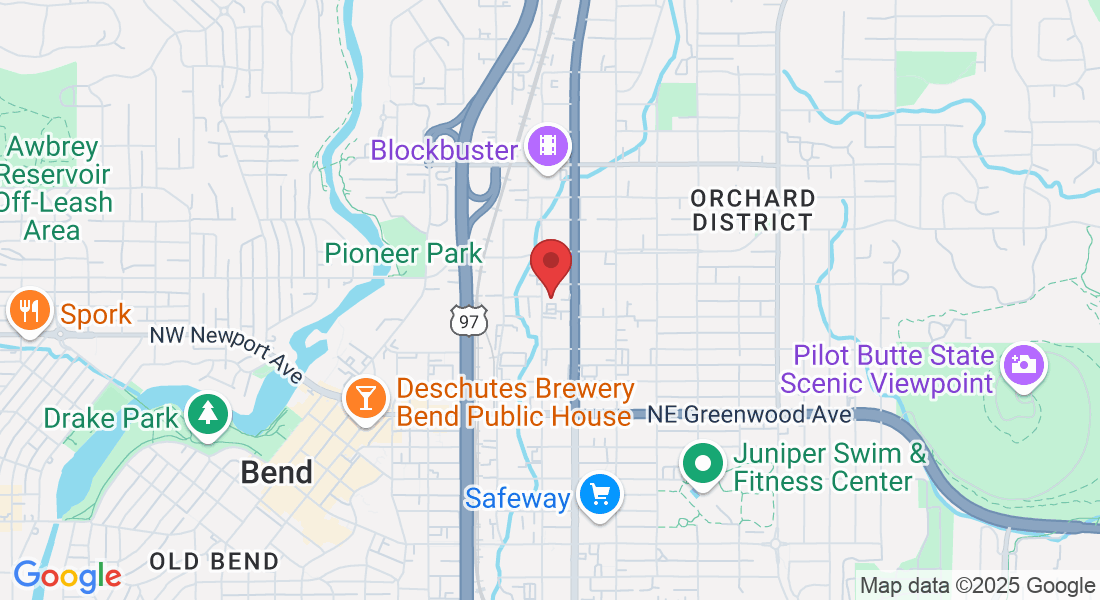Your Source for All Things Physical Therapy in Bend Oregon
The PhysioBLOG
Here, we share informative articles and insights that aim to help you achieve your full potential through our fitness-focused approach to rehabilitation. Our team is dedicated to providing you with valuable tips and techniques that can help you overcome any obstacle, whether you're recovering from an injury, surgery, or striving to build strength and wellness for life.
Stay up-to-date with our latest posts & empower yourself with elegantly simple techniques for optimal health & wellness.

Managing TMJ Disorders: How a Physical Therapist in Bend Can Help
Key Takeaway:
Physical therapists play a crucial role in managing TMJ disorders by providing specialized treatment and exercises aimed at improving jaw function and reducing pain.
Understanding the causes and symptoms of TMJ disorders is essential in developing an effective treatment plan. Physical therapists can help patients gain a better understanding of their condition and provide targeted therapies based on individual needs.
Long-term management of TMJ disorders involves a combination of physical therapy techniques, lifestyle modifications, and self-care strategies. By working closely with a physical therapist, individuals can learn how to manage their symptoms and improve their quality of life.
Introduction
TMJ disorders refer to problems with the temporomandibular joint, which connects the jawbone to the skull. Physical therapy can be an effective treatment option for managing these disorders. Through various techniques and exercises, physical therapists can help alleviate pain and improve functional movements of the jaw.
In addition to providing pain relief, physical therapists also play a crucial role in educating patients about self-management techniques and preventive measures for TMJ disorders. They assess the individuals' specific needs and develop personalized treatment plans to address their unique circumstances.
It is important to note that TMJ disorders can arise from various causes, such as stress, muscle tension, joint inflammation, or dental issues. By addressing the underlying causes and working towards restoring proper alignment and function, a physical therapist in bend can help to significantly enhance the quality of life for individuals suffering from TMJ disorders. We're a little partial to the experts here at PhysioFIT.
A long-lasting and remarkable case study involved a patient who had been experiencing severe TMJ pain for months. Physical therapy was incorporated into her treatment plan, consisting of manual therapy techniques, strengthening exercises, and relaxation techniques. Over time, her pain gradually subsided, and she was able to regain full jaw mobility, ultimately leading to a significant improvement in her overall quality of life.

Understanding TMJ Disorders
TMJ disorders refer to a range of conditions that affect the temporomandibular joint, which connects the jawbone to the skull. These disorders can cause pain and discomfort in the jaw, face, and neck, as well as difficulty chewing and speaking. Physical therapists play a crucial role in the management of TMJ disorders by utilizing various techniques to improve jaw mobility, reduce pain, and restore normal function.
By conducting a thorough evaluation, a physical therapist from PhysioFIT can accurately diagnose the specific type and underlying cause of TMJ disorders. They then design individualized treatment plans that may include manual therapy techniques, such as joint mobilizations and soft tissue mobilizations, to improve joint mobility. Additionally, a PT may incorporate exercises to strengthen the muscles around the jaw and neck, which can help alleviate pain and improve overall jaw function.
Furthermore, physical therapists may employ modalities such as heat or ice therapy to reduce inflammation and promote healing in the affected area. They also educate patients on proper posture, body mechanics, and relaxation techniques to minimize jaw strain and stress.
In addition, physical therapists can provide guidance on dietary modifications, including recommending softer foods or avoiding specific triggers, such as gum or hard candies, that may exacerbate symptoms. They may also suggest the use of oral splints or night guards to help realign the jaw and reduce clenching or grinding during sleep.
In summary, understanding TMJ disorders involves recognizing the range of conditions that can impact the temporomandibular joint and how physical therapists can assist in managing these conditions. Through a combination of manual therapy techniques, exercises, modalities, and patient education, physical therapists can effectively reduce pain, improve jaw function, and enhance the overall quality of life for individuals with TMJ disorders.
Physical Therapy Treatment for TMJ Disorders
Physical therapy can effectively treat TMJ disorders by employing various techniques and interventions. Therapists use a range of treatments to reduce pain and improve jaw function, such as manual therapy, exercises, and modalities like heat or cold therapy. Through specific exercises and stretches, physical therapy can help strengthen the jaw muscles, improve joint mobility, and correct any postural or muscular imbalances that may contribute to TMJ disorders.
Physical therapy treatment for TMJ disorders combines hands-on care, therapeutic exercises, and patient education to address the underlying causes and alleviate symptoms.
Managing TMJ Disorders Long-Term
An effective approach to ensure long-lasting management of TMJ disorders involves the valuable assistance that physical therapists can provide. With their expertise and techniques, physical therapists play a crucial role in helping individuals manage and alleviate the symptoms associated with TMJ disorders. Through a holistic approach that includes manual therapy, therapeutic exercises, and patient education, physical therapists can help patients regain normal jaw function and improve their overall quality of life. By addressing underlying muscle imbalances, improving joint mobility, and promoting proper jaw alignment, physical therapy can be an essential component in the long-term management of TMJ disorders.
To provide comprehensive care for individuals suffering from TMJ disorders, physical therapists use various techniques and modalities tailored to each patient's specific needs. These may include gentle mobilization techniques to improve joint mobility, myofascial release to relieve muscle tension, and exercises to strengthen and stabilize the jaw muscles. Furthermore, physical therapists educate patients about posture correction, stress reduction techniques, and proper oral habits that can contribute to the long-term management of TMJ disorders.
Additionally, physical therapists collaborate with other healthcare professionals, such as dentists and orthodontists, to ensure a multidisciplinary approach to managing TMJ disorders. Proper communication and coordination between healthcare providers are vital in creating an individualized treatment plan that addresses the unique needs of each patient. By working together as a team, healthcare professionals can provide comprehensive and effective long-term management for individuals with TMJ disorders.
Conclusion and Final Thoughts
In light of the information provided, it is evident that a thorough understanding of how physical therapists can assist in managing TMJ disorders is crucial. Physical therapy interventions, such as manual therapy and exercises, can effectively reduce pain and improve functional outcomes for individuals with TMJ disorders. Furthermore, patient education and active involvement in their treatment play a significant role in achieving successful outcomes.
Considering the complexity of TMJ disorders and the potential impact on an individual's quality of life, it is important for physical therapists to collaborate with other healthcare professionals, such as dentists and orthodontists, to provide comprehensive care. This multidisciplinary approach ensures that the treatment plan addresses the underlying causes of TMJ disorders and focuses on long-term management strategies. Moreover, by staying up-to-date with the latest research and evidence-based practices, physical therapists can continually enhance their knowledge and skills to deliver optimal care for patients with TMJ disorders.
It's worth noting that each individual may present with unique factors that contribute to their TMJ disorder, such as previous trauma or concurrent medical conditions. Therefore, physical therapists need to conduct a thorough evaluation to identify these factors and tailor the treatment plan accordingly. By addressing these individualized needs, physical therapists can optimize outcomes and promote patient satisfaction.
Overall, physical therapy plays a critical role in managing TMJ disorders. By utilizing evidence-based interventions, collaborating with other healthcare professionals, individualizing treatment plans, and empowering patients, physical therapists can provide comprehensive care and improve the quality of life for individuals with TMJ disorders.
Five Facts About Managing TMJ Disorders: How Physical Therapists Can Help:
✅ Temporomandibular joint disorder (TMD) affects people of all ages and genders, but women of childbearing age are affected three times more than men.
✅ TMD symptoms include jaw pain, difficulty fully opening the mouth, and "crackling" or "popping" noises when moving the jaw.
✅ TMD can be caused by trauma from dental work, car accidents, or blows to the face, as well as chronic teeth clenching and grinding, and tension in the neck and face from stress and poor posture.
✅ Physical therapists are movement experts who can evaluate, treat, and help manage TMD to relieve symptoms, reduce pain, and improve mouth function.
✅ Physical therapy treatment for TMD may include education on proper posture and body mechanics, modalities such as heat or ice, soft-tissue release techniques, and exercises to restore jaw function.
FAQs
What is temporomandibular joint disorder (TMD) and how can physical therapists help?
Temporomandibular joint disorder (TMD) is a condition that affects the jaw and can cause symptoms such as pain, difficulty opening the mouth fully, crackling or popping noises, earache, headache, and dizziness. Physical therapists are movement experts who can evaluate and treat TMD to relieve symptoms and improve mouth function.
What are the common causes of temporomandibular joint disorder (TMD)?
TMD can be caused by various factors, including trauma from dental work, car accidents, or blows to the face. Chronic teeth clenching and grinding at night, tension in the neck and face from stress, poor posture habits, abnormal teeth alignment, jaw fractures, surgery, muscle spasms, displacement of the disc or soft-tissue cushion, and arthritis can also contribute to TMD.
How does temporomandibular joint disorder (TMD) feel?
TMD can cause jaw pain, difficulty fully opening the mouth, shifting of the lower jaw, noises in the jaw, headaches, neck or facial pain, dizziness, earache, jaw fatigue, lockjaw, difficulty swallowing, problems with speaking, and a sense of anxiety or helplessness. However, jaw pain can also be a symptom of a heart attack, so it's important to seek medical care immediately if you experience jaw pain along with other symptoms such as chest pain, shortness of breath, or numbness in the left arm.
How is temporomandibular joint disorder (TMD) diagnosed?
A physical therapist will take a detailed history of your condition and evaluate your head, neck, and temporomandibular joint (TMJ). They will assess your posture, breathing pattern, stress level, and other factors that may contribute to your condition. If teeth alignment is suspected to be a cause of TMD, a referral to a dentist or orthodontist may be made. A night splint may also be recommended to aid in treatment.
How can physical therapists help in managing temporomandibular joint disorder (TMD)?
Physical therapists can help reduce pain and restore jaw function in individuals with TMD through various treatment approaches. This may include patient education on posture, body mechanics, tongue resting position, and self-management routines. Modalities such as heat or ice, ultrasound, electrical stimulation, and light therapy may be used. Hands-on treatments like soft-tissue release can be performed to mobilize the jaw and surrounding structures.
Ask The Experts

PT, MSPT, OCS, CF-L1

PT, DPT, TPI, CF-L1

PT, DPT, CSCS
Copyright PhysioFIT 2025 . All Rights Reserved


